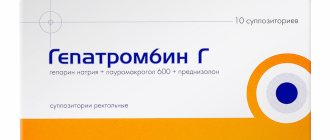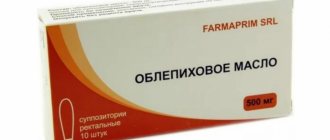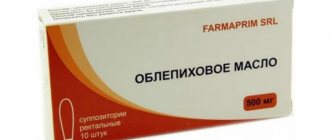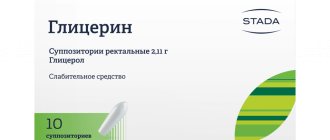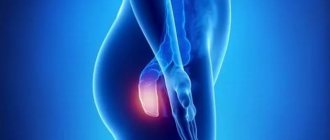A sedentary lifestyle, taking certain medications, stress, or hemorrhoids can cause difficulty bowel movements. Due to the immaturity of the gastrointestinal tract, young children, as well as when switching to artificial feeding or introducing complementary foods into the diet, may also experience problems with stool.
Treatment of chronic disorders involves taking medications. As an emergency measure, suppositories with glycerin for constipation will come to the rescue.
The mechanism of action of suppositories with glycerin
The medication belongs to the group of laxatives with dehydrating and dermatoprotective effects.
The therapeutic effect occurs due to the action of the active component - glycerin, which softens fecal stones and facilitates their movement through the large intestine.
The substance irritates the mucous membrane, thereby activating intestinal motility.
After insertion into the rectum, glycerin suppositories quickly melt, so the laxative effect of their use occurs in 15-30 minutes or earlier, depending on the condition and personal characteristics of the body.
Softening laxatives
These drugs include the following:
- glycerol;
- oils: vaseline, almond;
- liquid paraffin;
- docusate sodium.
Softening substances help soak stool with water, make its consistency softer, and facilitate the passage of stool. Such laxatives literally lubricate the intestinal mucous membranes. However, today drugs of this group are used relatively rarely, which is associated with side effects when taking them.
In the work of Doctor of Medical Sciences, Professor Minushkin O.N., there is the following information about this: “The costs of drugs that soften fecal matter (or “lubricate”) <…> reduce the absorption of fat-soluble vitamins” (Minushkin O.N., 2003, p. 52).
In what cases will glycerin suppositories help?
The instructions for glycerin suppositories contain a list of conditions for which they are prescribed. The main indication is difficult defecation or its absolute absence, caused by functional disorders of the gastrointestinal tract, old age/childhood, and psychological problems.
For preventive purposes, suppositories are prescribed to patients after surgical interventions and for pathologies that require the elimination of physical stress.
Including:
- anorectal abscess;
- anal fissures;
- hemorrhoids complicated by blood clots and pain;
- narrowing of the rectal lumen;
- suffered myocardial infarction.
Suppositories with glycerin can be used in preparation for rectal surgery, to prevent constipation after surgery, to avoid constipation after childbirth, and also before examining the rectum with instruments or x-rays.
Contraindications for use, side effects
Glycerin suppositories for constipation are prohibited for use when:
- personal intolerance or hypersensitivity to glycerin or additional substances;
- diarrhea;
- irritable bowel syndrome;
- abdominal pain of unknown origin;
- intestinal obstruction;
- hemorrhoids in the acute phase;
- tumors, polyps and fissures in the rectum;
- inflammatory processes in the rectum (proctitis);
- acute inflammation of the appendix;
- bleeding in the rectum;
- pregnancy.
Under the supervision of a physician, they can be used for renal failure and during breastfeeding.
The use of suppositories with glycerin can cause:
- manifestations of allergies;
- discomfort in the anus (burning, itching);
- with frequent and prolonged use, the physiological process of bowel movement may weaken;
- in case of overdose – symptoms of irritable bowel (frequent loose stools).
Modern problems of complex therapy of constipation
Constipation is a decrease in the frequency of stools and difficulty in defecating, usually for two days or more, which can lead to pain, discomfort in the abdomen, subsequent obstruction of the intestinal lumen and, rarely, perforation. The term “constipation” is understood as a persistent or intermittent dysfunction of the colon with a decrease in stool less than three times a week and with forced straining, occupying more than 25% of the time of defecation. Constipation is a common and usually subjective complaint. Predisposing factors include physical inactivity, refined, easily digestible foods, and inadequate timing of bowel movements. According to statistics, 30–50% of the adult population suffers from constipation. They are leading among the reasons for visiting therapists and gastroenterologists.
Working classification of constipation
- Primary constipation (with intestinal diseases):
A. Functional constipation (“habitual”):
- rectal constipation (dyschezia) - a sharp weakening of the defecation reflex;
- cologenic constipation is a slowdown in the intestinal passage of chyme as a manifestation of dyskinetic disorders.
- B. Organic constipation. Develops with structural lesions of the intestine: colitis, dysbiosis, anal fissure, hemorrhoids, cryptitis, papillitis, cicatricial narrowing of the colon, prolapse of the perineum and prolapse of the rectal mucosa, cancer and other intestinal tumors, elongated colon, idiopathic megacolon.
- Secondary constipation (caused by extraintestinal causes):
- a) reflex (for peptic ulcers, cholecystitis, nephrolithiasis, gynecological diseases);
- b) for diseases of the endocrine (myxedema, diabetes mellitus) and nervous systems (spinal cord diseases, parkinsonism);
- c) metabolic and toxic (porphyria, lead poisoning, anticholinergics, ganglion blockers, iron supplements, diuretics, sedatives);
- d) muscular constipation: damage to the muscles (diaphragm, abdominal wall, anus) involved in the passage of feces and the act of defecation: myopathy, scleroderma, pulmonary emphysema;
- d) psychogenic.
- Idiopathic constipation.
Constipation is divided into acute, which occurred less than three months ago, and chronic, which lasts longer.
Clinic and diagnostics
The frequency of bowel movements can vary: from once every 2-3 days to once a week or less. Feces are usually compacted, dry, have the appearance of balls or lumps, reminiscent of sheep; can be bean-shaped, ribbon-shaped, cord-shaped. Patients may be bothered by pain and a feeling of fullness in the abdomen; relief comes after defecation or passing of gas. Appetite may decrease, belching of air, and bad taste in the mouth may appear. Often the ability to work decreases, headaches, myalgia, nervousness, depressed mood, and sleep disturbances occur. Persistent constipation may be accompanied by skin changes. It becomes pale, yellowish, flabby, and loses elasticity.
The duration of constipation should be clarified. Acute constipation is often “situational”. For example, constipation in tourists, when consuming refined foods, medications, due to emotional factors. They may be associated with exacerbation of chronic diseases of the upper digestive tract (peptic ulcer) or anorectal area (thrombosis of hemorrhoids, anal fissure).
Taking an anamnesis helps in differentiating constipation from transit and evacuation disorders. The first will be supported by a decrease in bowel movements and flatulence. Disorders of the act of defecation can be assumed when there is a feeling of obstruction or incomplete emptying of the rectum, and the need for manual assistance.
A clinical examination of the patient is carried out; digital examination of the rectum, sigmoidoscopy, and irrigoscopy are desirable. In case of chronic constipation, emphasis should be placed on searching for concomitant neuroendocrine disorders, mental disorders, collagenosis, and metabolic pathologies. It is necessary to clarify whether the patient is taking medications and which ones.
For example, with diabetic autonomic neuropathy, constipation occurs in 60% of patients; with pheochromocytoma, they occur no more often than in 15%. Barium sulfate can cause constipation in susceptible individuals after a single dose, but antidepressants only with long-term use.
If the patient’s condition worsens with increasing constipation, weight loss, anemia, it is necessary to exclude a tumor of the colon or internal organs. The diagnostic program is complemented by colonoscopy with targeted biopsy and ultrasound of the abdominal and pelvic organs.
During the first stage of the diagnostic search, it is necessary to exclude tumor and inflammatory diseases, identify endocrine and mental pathologies, and determine megacolon and megarectum. These diseases require fundamentally different treatment and can be diagnosed during examination, colonoscopy or irrigoscopy.
After excluding them, patients can be offered trial therapy, including dietary fiber, motor correctors, and regulation of the urge to defecate. A positive response to treatment allows the diagnosis to be stopped and maintenance therapy to be carried out. Patients with refractory constipation are subject to in-depth examination. The criterion for treatment failure is the lack of positive dynamics when using dietary fiber. In these cases, an intestinal transit study, sphincterometry, and electromyography will be required.
Treatment
Treating constipation is quite a difficult task. Continuous attempts to develop an effective long-acting treatment regimen have not yet yielded results. Obviously, the mechanism that partly explains this fact, and the factor that is most difficult to influence, is the psychosocial environment.
Patients are advised to increase their consumption of wholemeal products, fresh and dried fruits and vegetables, and take more fluids. Patients should avoid taking herbal laxatives and high cleansing enemas. Microenemas of up to 200 ml in volume daily in the morning are acceptable in order to develop the urge to defecate.
Drug therapy is prescribed taking into account the predominance of certain symptoms. Drugs of different groups can be used constantly or as needed, in the latter case it is recommended for patients with periodically occurring symptoms. In patients refractory to treatment, drugs with different mechanisms of action are combined.
Special treatment includes eliminating intestinal obstruction (fecal stones, tumor), avoiding the use of drugs that inhibit peristalsis (antacids containing aluminum and calcium, opiates).
Fiber (dietary fiber) (20–30 g/day) is good for chronic constipation, but it only works after a few weeks and can cause flatulence. Dietary fiber (DF) is a product of plant origin containing non-fermentable substances of a polysaccharide nature - cellulose, hemicellulose, lignin. They regulate the consistency of stool, increase its mass and speed up the movement of contents. PIs bind fatty acids (natural laxatives), delivering them to the colon. People suffering from constipation have insufficient fiber intake or an increased need for dietary fiber. To make up for the daily need for dietary energy, you need to eat up to 1.5 kg of wholemeal bread, cabbage and apples, which is unrealistic for a modern person.
PF includes wheat bran, microcrystalline cellulose (MCC), agar-agar, laminaride, flaxseed. Wheat bran is added to food, and plantain seed is mixed with water and taken 2-4 times a day. It is usually recommended to start taking bran 3 to 6 tablespoons per day with food, pouring boiling water over it. The amount of fluid is increased to 2–3 liters per day.
Wheat bran does not immediately exert its effect; the latent period can be 5–7 days. This is the time required for the bran taken orally to enter the ampulla of the rectum and be ready for defecation.
If the effect is not achieved, it is possible to use MCC at a dose of 4–9 g per day or the preparation from plantain seeds Mucofalk (10–30 g per day). The latter retains liquid more strongly, does not produce intense gas, and is better tolerated by patients. Dietary fiber can be combined. However, their use is limited if the patient is not able to increase fluid intake, which is fraught with the development of obstruction.
Laxatives are prescribed when fiber is ineffective. Their long-term use is undesirable. For abdominal pain of unknown origin or intestinal obstruction, laxatives are contraindicated.
- Softening laxatives: docusate sodium, 50–200 mg orally once daily. Vaseline oil when taken orally and oil enemas, Norgalax, Enimax also have fecal softening properties. For obstruction, the use of petroleum jelly for several days is quite justified. Longer treatment may lead to impaired absorption and granulomatous reactions. Drugs in this group have limited use.
- Agents that stimulate intestinal motility. Long-term use of these drugs is not recommended. Castor oil (15 ml orally) causes rapid emptying of the colon. Bisacodyl is taken in the evening - orally (10–15 mg) or rectally (10 mg suppositories); defecation occurs within 15–60 minutes. Buckthorn and senna extracts induce bowel movements 10–16 hours after ingestion; with long-term use, atony of the colon is possible. The usual dose of buckthorn extract is 5 ml orally once a day; Senna extract is taken 1 tablet orally 1-2 times a day. Sodium picosulfate (Guttalax, Laxigal, Slabilen) is taken starting with 12 drops at night.
The plant origin of laxatives in this group often determines their choice by patients for self-medication. They are also included in many herbal teas. However, their use should be a necessary measure when other methods of normalizing intestinal function have been exhausted. As the duration of their use increases, the effectiveness of treatment decreases, and the chances of normalizing bowel function decrease.
Most patients taking stimulant laxatives report increased abdominal pain. Thus, senna anthraquinones exert their effect through damage to epithelial cells, which leads to impaired absorption, secretion and motility. Melanosis of the mucous membrane is observed, and in a third of patients an “inert” colon is formed. Patients with melanosis have an increased risk of developing carcinoma. However, short-term use may be considered safe. By “strength”, herbal preparations can be arranged as follows: aloe ® senna ® buckthorn ® rhubarb. To a certain extent, the above applies to both bisacodyl and sodium picosulfate. However, the effect of sodium picosulfate is milder. These drugs should be used once every 3-4 days in the minimum effective dose, which will allow you to maintain sensitivity to them for a longer time and avoid negative consequences.
- Osmotic laxatives are non-absorbable salts and carbohydrates that retain fluid in the lumen of the colon. Their immediate effect is higher than the effect of dietary fiber. A number of drugs in this group, like magnesia, are used for a short time when it is necessary to induce rapid bowel movement, for example, to prepare a patient for irrigoscopy, others are intended for prolonged use - lactulose, Forlax. Lactulose is a synthetic, non-absorbable polysaccharide that reaches the ileum, where it is broken down to form lactic and other acids. This leads to a decrease in pH, an increase in osmotic pressure and stimulation of peristalsis. Lactulose (Lactulose, Duphalac, Portalac) at a dose of 30–45 ml per day has an effect after 48 hours, but it is often accompanied by a feeling of bloating and distension in the abdomen. Forlax, a polyethylene glycol with a molecular weight of 4000, has the best tolerability. The drug has no side effects, does not affect microflora, and gives a quick effect. Its use is possible for a number of months and even years. Habituation does not develop. The dose of Forlax ranges from 30 to 60 g per day, and in high doses it is also effective for refractory constipation. Dietary fiber and osmotic laxatives are combined with each other, and the dosage of both can be reduced in combination treatment.
A solution of polyethylene glycol with sulfates and other salts is used to quickly cleanse the colon in preparation for endoscopy or surgery. The solution is taken orally, 4–6 liters over 3–4 hours.
When complaints of bloating and flatulence predominate in the clinic, the prescription of drugs is indicated, the mechanism of action of which is based on reducing the surface tension of gas bubbles, which ensures resorption and free release of gases. One of these drugs is Espumisan (the active ingredient is simethicone). It is not absorbed in the digestive tract and is excreted unchanged from the body. By reducing the surface tension at the interface, simethicone impedes the formation and promotes the destruction of gas bubbles in the nutrient suspension and mucus of the gastrointestinal tract (GIT). The gases released during this process can be absorbed by the intestinal walls or excreted through peristalsis. For flatulence, 2 capsules of simethicone are prescribed 3-5 times a day.
There are 4 generations of PB. The first generation includes monocomponent preparations (Colibacterin, Bifidumbacterin, Lactobacterin) containing one strain of bacteria. Second generation drugs (Baktisubtil, Biosporin and Sporobacterin) are based on microorganisms that are non-specific for humans and are self-eliminating antagonists. They can be used to treat severe forms of dysbiosis, but must be combined with bifido- and lactose-containing PBs, which are necessary to normalize the intestinal microbiocenosis. III generation drugs include multicomponent PBs containing several symbiotic strains of bacteria of the same species (Acilact, Acipol) or different species (Linex, Bifiform) that enhance each other's effects. The benefits of third generation drugs are especially evident in patients with decompensated intestinal dysbiosis. The fourth generation includes preparations of bifid-containing PBs immobilized on a sorbent (Bifidumbacterin forte, Probifor). Sorbed bifidobacteria effectively colonize the intestinal mucosa, providing a more pronounced protective effect than unsorbed analogues.
One of the most frequently prescribed probiotics in Russia is Linex. This is a combined drug containing components of natural microflora from different parts of the intestine. It is used for the prevention and treatment of intestinal dysbiosis, including dysbiosis as a result of treatment with antibiotics, diarrhea, constipation, flatulence, nausea, vomiting, regurgitation, abdominal pain.
Linex Bio is a dietary supplement, a source of probiotic microorganisms, inulin and oligofructose. Combines the properties of pro- and prebiotic agents. Used to prevent the development of intestinal dysbiosis in healthy people.
The balanced composition of Linex is primarily confirmed by the fact that its components allow for the normalization of the functions of all parts of the intestine - from the small intestine to the rectum (enterococci predominantly populate the small intestine, lactobacilli - its lower sections and the large intestine, bifidobacteria - the large intestine).
Bifidobacteria, lactobacilli and non-toxigenic lactic acid enterococcus included in Linex maintain and regulate the physiological balance of intestinal microflora and provide intestinal functions, including motor function, mainly through the production of organic acids and lowering the pH of intestinal contents. Enterococci, in particular, carry out fermentative metabolism, ferment carbohydrates with the formation of lactic acid and also reduce the pH in the intestines to 4.2–4.6. Linex components are also involved in the metabolism of bile acids (in the formation of stercobilin, coprosterol, deoxycholic and lithocholic acids, reabsorption of bile acids). As has long been known, the normal amount and properties of bile have a clear anti-obstipation effect.
The effectiveness of probiotics containing lactobacilli and bifidobacteria, such as Linex, has been demonstrated for irritable bowel syndrome (IBS) with constipation. Treatment led to a decrease in pain and flatulence, and an improvement in the quality of life of patients [Belmer S.V., 2004]. In a clinical study, 4-week therapy with a combination of probiotics similar in composition to Linex (Bifidobacterium, Lactobacillus and Enterococcus) caused a significant improvement in symptoms, especially abdominal pain and stool character, in 74.3% of patients; after cessation of treatment, a stable effect persisted for 2 weeks of observation. In another randomized study, the use of a similar combination made it possible to prolong remission in patients with IBS associated with constipation: exacerbation was observed in only 15% of those receiving probiotics, while in the placebo group - in 100% of cases [Ivashkin V.T., Lapina T.L. ., 2003].
The mechanism of action of Linex for constipation due to IBS remains unclear. It is believed that it may also be associated with its beneficial effect on gas formation in the intestines due to inhibition of the growth of gas-producing microflora.
The duration of Linex therapy depends on the cause of constipation. When using the drug in recommended doses, no side effects were noted. Contraindications: hypersensitivity to the components of the drug or dairy products. The use of Linex is not contraindicated during pregnancy and lactation.
To preserve the viability of the drug components, it is not recommended to take Linex with hot drinks. During the period of using Linex, you should refrain from drinking alcohol.
Colon motility correctors
This group of drugs includes selective antispasmodics and prokinetics. Patients with spastic constipation syndrome have reason to expect success from treatment with antispasmodic drugs (Meteospasmil, Dicetel, Spasmomen, Duspatalin, Buscopan), while prokinetics (cisapride, domperidone) should be used in patients with atonic constipation.
Abdominal pain is eliminated by antispasmodics that regulate, rather than paralyze, intestinal motility. One of them is mebeverine (Duspatalin). The drug acts by reducing the permeability of intestinal smooth muscle cells to Na+. Prescribed 2 tablets or 1 capsule (200 mg) 2 times a day or 1 tablet (135 mg) 3 times a day 20 minutes before meals.
Pinaveria bromide (Dicetel) has an antispasmodic effect by blocking the entry of Ca2+ through calcium channels into intestinal smooth muscle cells. Prescribed 1 tablet (50 mg) 3-4 times a day with meals.
Otilonium bromide (Spazmomen) has an antispasmodic effect as a result of disruption of the mobilization of Ca2+ from the intracellular and extracellular space of intestinal smooth muscle cells without affecting the cell membrane receptors. Prescribed 1-2 tablets (20-40 mg) 2-3 times a day before meals.
Cisapride (Coordinax) , a 5-HT4 serotonin receptor agonist, promotes the release of acetylcholine in the intestinal nerve ganglia. The drug accelerates transit through the colon, stimulates colonic motility, and reduces the sensitivity threshold of the rectum to defecation. However, doses less than 30 mg per day do not have a noticeable effect. Due to the risk of cardiac arrhythmias, it should not be used in elderly patients.
In recent years, new drugs have appeared that selectively act on 5-HT4 receptors, in particular, prucalopride.
In general, serotonergic drugs are considered a promising group of drugs for relieving symptoms of constipation. Serotonin has a pronounced effect on intestinal motility through activation of receptors located on effector cells and in nerve endings. 5-HT3 and 5-HT4 receptors play a leading role in nociception by modulating the afferent side of visceral reflexes. Stimulation of these receptors leads to the release of acetylcholine and substance P, which are transmitters of gastrointestinal sensitivity. 5-HT3 receptor antagonists include motility inhibitors (used for irritable bowel syndrome), while drugs that activate 5-HT4 receptors have a stimulating effect on peristalsis. Currently, the partial 5-HT4 receptor agonist tegaserod is available from this group of drugs.
Biofeedback technique
The main method of treating patients with “exit obstruction” is biofeedback (BFB). Two types of training are described: 1) biofeedback training, in which sensory sensors are placed in the anal canal and monitor the activity of the transverse muscles or pressure in the anal canal, and thus provide feedback to the patient; 2) simulated defecation, in which the patient practices defecation with a simulated stool. Both types of training give up to 85% positive effect. The method is effective not only in patients with defecation disorders, but also in slowing down transit, which is explained by additional psychotherapeutic effects.
Differentiated therapy
For nutritional constipation, it is necessary to increase physical activity and achieve a balanced diet; in more complex cases, use dietary fiber and bacterial preparations (Linex). In patients with gallbladder dysfunction, prescribing a herbal mixture of peppermint, chamomile, immortelle, and tansy will increase the effectiveness of treatment.
For severe constipation while taking opiates, osmotically active agents (lactulose, polyethylene glycol solutions) and emollient laxatives administered orally or rectally (sodium docusate), or mineral oil are effective.
Constipation after cholecystectomy is more difficult to treat. These patients, and equally patients with diabetes, respond better to Forlax. For atonic or slow-transit constipation, cisapride (Coordinax) is used along with dietary fiber or osmotic laxatives. In case of “exit obstruction,” the patient needs additional examination in a hospital setting, as well as trial treatment with biofeedback.
With long-term and long-term use of laxatives containing anthraquinones, their abolition and transfer of patients to dietary fiber and osmotic laxatives is often impossible. In such cases, sodium picosulfate is used once every 2-3 days with increasing intervals between doses and withdrawal. The restructuring of intestinal activity may take 3–6 months. If the abolition of stimulant laxatives is impossible, they take the path of reducing the dose and alternating them. In this case, it is advisable to continue taking dietary fiber.
Patients with abnormally prolonged transit and normal pelvic floor parameters, refractory to drug therapy, are considered candidates for surgical treatment.
Forecast
The prognosis for life is favorable. The course of the disease is chronic, relapsing, slowly progressive. Constipation is rarely complicated by bleeding, perforation, strictures, fistulas, or intestinal obstruction. This determines the tactics for monitoring patients and the lack of need for frequent colonoscopies. The doctor should familiarize patients with the features of the prognosis of the disease, which will improve their psychosocial adaptation.
At the same time, the patients’ ability to work is impaired. As a cause of temporary disability, the diagnosis of constipation syndrome in the world comes in second or third place after acute respiratory infections/ARVI. The quality of life of patients with constipation syndrome in terms of nutrition, sleep, rest, sexual activity, family and social status is reduced.
Literature
- Grigoriev P. Ya., Yakovenko A. V. Clinical gastroenterology. M.: MIA. 2001.
- Zlatkina A. R. Pharmacotherapy of chronic diseases of the digestive system. M.: Medicine, 1998.
- Ivashkin V. T. Irritable bowel syndrome. Practical guide for doctors. M.: RGA, 1999.
- A short guide to gastroenterology. Ed. V. T. Ivashkina, F. I. Komarova, S. I. Rapoport. M.: LLC Publishing House M-Vesti. 2001.
- Bonapace C., Mays D. The effect of mesalamine and nicotine in the treatment of inflammatory bowel disease // Ann. Pharmacother., 1997, 31 (7–8), 907–913.
- Cohen R., Hanauer S. Immunomodulatory agents and other medical therapies in inflammatory bowel disease // Curr. Opin. Gastroenterol., 1995, 11, 321–330.
- Drossman D., Whitehead W., Camilleri M. Irritable bowel syndrome: a technical review for practice guideline development // Gastroenterology, 1997, 112, 2120–2137.
- Hanauer S. Inflammatory bowel disease // N. Engl. J. Med., 1996, 334 (13), 841–848.
- Hanauer S., Schulman M. New therapeutic approaches // Gastroenterol. Clin. North Am., 1995, 24, 523–540.
- Maxwell P., Mendall M., Kumar D. Irritable bowel syndrome // Lancet, 1997, 350, 1691–1695.
- Spencer C., McTavish D. Budesonide. A review of its pharmacological properties and therapeutic efficacy in inflammatory bowel disease // Drugs, 1995, 50 (5), 854–872.
- Thompson W., Creed F., Drossman D. et al. Functional bowel disease and functional abdominal pain // Gastroenterology Int., 1992, 5, 75–91.
V. V. Skvortsov, Doctor of Medical Sciences, Associate Professor A. V. Tumarenko, Candidate of Medical Sciences E. M. Skvortsova O. V. Orlov V. V. Odintsov A. M. Yusupova VolSMU, Volgograd
Is it possible for pregnant women and children
The drug is contraindicated for women during pregnancy due to the risk of stimulating the uterus and provoking miscarriage or premature birth.
During lactation, it is allowed as prescribed by a doctor and when assessing the possible risks for the child, since no studies have been conducted on the penetration of glycerol into breast milk.
Children from birth to three years old, with the consent of the pediatrician, are allowed to administer ½ suppository for children once a day. At the age of 3-7 years, a suppository for children in full can be administered once.
Children starting from school age are prescribed suppositories for adults.
How to use glycerin suppositories
The product is used rectally. After inserting the suppository into the rectum, it is advisable to lie down for at least 10 minutes so that the melted suppository does not leak out.
Application schemes:
- adult patients and children over 7 years old - one suppository with a dosage of 2.11 g once every 24 hours;
- children 3-7 years old - one suppository with a dosage of 1.24 g no more than once a day;
- children under 3 years old – half a candle with a dosage of 1.24 g once.
If these doses are ineffective, they can be doubled.
special instructions
The drug is not recommended for regular use. The use of suppositories is stopped as soon as normal intestinal motility is restored. Before insertion, do not lubricate the anus or suppository with mineral oils, both solid and liquid.
For chronic hemorrhoids outside the acute phase, the medication is indicated for constipation lasting from two to three days. In the acute period, when there is bleeding and inflammation, the use of glycerin suppositories is prohibited.
After complicated childbirth, accompanied by the application of any types of sutures, in order to avoid violating their integrity when straining, suppositories are used in the absence of stool for a long time or for prevention, only after consultation with a doctor.
Folk remedies for constipation for older people at home
Medicinal herbs are recommended to be used only after consultation with the attending physician. Infusions and decoctions made from plant materials have quite a few contraindications, so such products should be used with caution.
Remedies for constipation for older people at home, offered by traditional medicine:
- Compote of dried fruits, which must contain raisins, prunes, and dried apricots. They have a mild laxative effect. Directions for use: leave for 24 hours, drink 0.2 liters in the morning before meals.
- Boiled beet salad seasoned with vegetable oil stimulates contraction of the intestinal tube walls in older people. If gastritis is diagnosed, then the root vegetable should not be eaten.
- Fresh one-day fermented milk drinks - yogurt and kefir - in combination with vegetable oil. To prepare the medicine, you need to add one tablespoon of oil to 0.2 liters of drink.
- It is advisable to include bran in the daily diet of older people to relieve constipation. The recommended dosage is adding three to four tablespoons daily to first and second courses.
- Flax seeds are a good remedy for normalizing bowel movements. Method of preparing the drug: leave one and a half teaspoons of flax seeds poured with boiling water until mucus forms. You need to take half a glass of mucus only, excluding seeds, during the day.
- Elderberries are another folk remedy for constipation for the elderly. To prepare it, you need to boil the washed black elderberries together with sugar for 20 minutes in an enamel pan over low heat. For one liter of berries you need to add one glass of granulated sugar. It is recommended to take three tablespoons of the resulting product before meals in the morning and evening.
Many people have the impression that constipation medications for older people at home are preferable to medications. However, there are also restrictions on their use, so the use of traditional recipes also needs to be agreed with your doctor.
Medicines and traditional medicine for the treatment of constipation in older people have the following general contraindications:
- intestinal obstruction;
- gastrointestinal ulcer;
- intestinal bleeding.
Side effects of taking medications for constipation may include allergic reactions due to individual intolerance to the components, increased gas formation, diarrhea, and flatulence.
Constipation in older adults is a serious problem that needs to be addressed. This can be done by choosing the right medications. Moreover, treatment must be not only effective, but also safe.
We recommend
“Mattresses for the elderly: types, features, selection criteria” Read more
